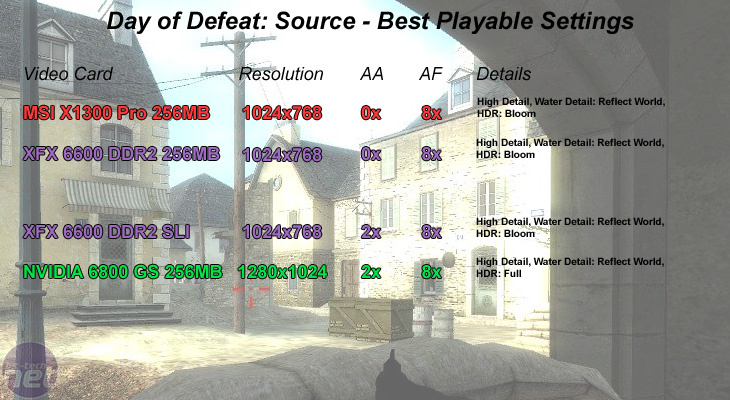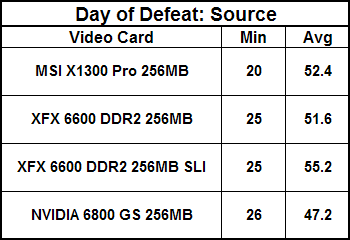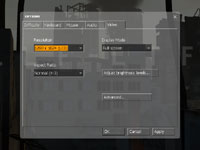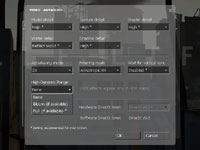Day of Defeat: Source
Publisher: ValveWe used the popular remake of the World War II online multiplayer, Day of Defeat: Source, which uses Valve's implementation of high-dynamic range rendering. We did three five minute portions of real world game play on the dod_anzio map. We connected to three different public servers each with a ping of less than 30ms and 16-20 players in the game when we were recording the frame rates.
Anti-Aliasing and Anisotropic Filtering were controlled from inside the game, and thus the drivers were left set to "Application Controlled". There are three options for the method of HDR used in this title. You can either disable HDR completely, make use of "Bloom" which is just what it says and less resource hungry in comparison to "Full" which, again is just what it says. It utilises a full dynamic range with the iris effect too.
We have written quite a bit about Half-Life 2: Lost Coast, Day of Defeat: Source and how Valve have implemented HDR in to the Source Engine. You can check out the articles listed below for more information on The Lost Coast & Day of Defeat: Source.
- Half-Life 2: Lost Coast HDR overview
- Half-Life 2: Lost Coast hands on
- Half-Life 2: Lost Coast Benchmarks & Video
- Day of Defeat: Source
Below is a table of the best-playable settings that we found best for each video card configuration. We found that 25 frames per second is the required minimum, and a target of 45-50 frames per second (or higher) is the average frame rate in our manual run throughs on these mainstream video cards.


The same could be said for the XFX GeForce 6600 DDR2, too. It seemed better at holding a higher frame rate, but you would be hard pushed to notice a difference between it and the MSI Radeon X1300 Pro. The only distinct difference would be the superior anisotropic filtering quality on the MSI Radeon X1300 Pro. We were not able to use high quality anisotropic filtering, but the improved filtering algorithms on Radeon X1000-series do make a bit of a difference.
When we paired two XFX GeForce 6600 DDR2's in SLI, we found that we were able to increase the image quality with 2xAA, but we were not able to increase the in-game details any further. The gameplay experience was much better with 2xAA applied, as it removed a lot of the jaggies from the scenery. As the game is set in the daylight, aliased textures and edges can be really apparent - 2xAA helped to remove some of the edge aliasing, resulting in a better gaming experience.
The GeForce 6800 GS was in a league of its own in Day of Defeat: Source. We have known for a long while that there is a slight CPU limitation in Valve's Source engine. In this case, we feel that it could have affected the SLI performance, as we were not able to push the XFX 6600 DDR2 SLI any further than we did without suffering choppiness.
The thing that the GeForce 6800 GS had going for it was its ability to hold a higher minimum frame rate with higher detail settings. In fact, we were able to achieve smoother gameplay at 1280x1024 2xAA 8xAF with high details, full HDR and water detail set to reflect world. At these settings we were able to enjoy the game without fear of graphical hiccups.
The average frame rate was slightly lower than what we experienced when we tested the video card with an Athlon 64 3700+, but you will be able to increase that with a bit of overclocking on your CPU. Ultimately, the average frame rate will depend on your CPU because of the slight CPU limitation that we have highlighted before in the Source engine.

MSI MPG Velox 100R Chassis Review
October 14 2021 | 15:04








Want to comment? Please log in.